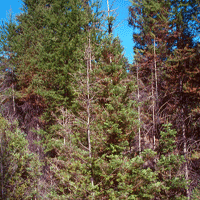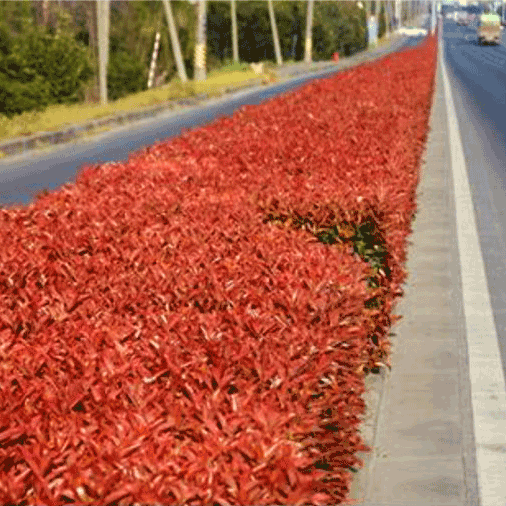Phytoremediation is an effective and affordable approach to extract or remove lead from contaminated soil. An understanding of the physiological responses of different species subjected to heavy metal contamination is necessary before considering their use for environmental clean-up. The objective of this study was to assess the effect of lead (Pb) on growth and nutrient uptake in three forest species native to Iran: Cappadocian maple (Acer cappadocicum), European ash (Fraxinus excelsior) and Oriental aborvitae (Platycladus orientalis). The capability of lead uptake in different organs was studied in one-year-old potted seedlings grown in contaminated soils with Pb concentration ranging from 100 to 500 mg kg-1 for six months in a nursery. Several phytoextraction parameters such as translocation factor (TF), tolerance index (TI) and bioconcentration factor (BCF) were assessed to investigate the phytoremediation potential of these species. Increasing Pb application in the soil caused a gradual decrease in dry weight of leaf and shoot of all species, while the dry weight of root remains unaffected. However, such inhibition was less marked in the conifer (P. orientalis) compared to the two broad-leaf species. Phosphorus uptake of all species slightly declined in contaminated soils. Contrastingly, Pb application did not hinder nitrogen and potassium uptake in seedlings. Atomic absorption thermo electron analysis of Pb-treated plants showed an increasing Pb accumulation in all plant compartments, although the result was more evident in the tissues of P. orientalis. This species also showed the highest values for TF, TI and BCF, indicating this conifer species as a potential candidate for phytoremediation of lead-polluted soils in Iran.
Keywords
, , , , , , ,
Citation
Abbasi H, Pourmajidian MR, Hodjati SM, Fallah A, Nath S (2017). Effect of soil-applied lead on mineral contents and biomass in Acer cappadocicum, Fraxinus excelsior and Platycladus orientalis seedlings. iForest 10: 722-728. - doi: 10.3832/ifor2251-010
Academic Editor
Claudia Cocozza
Paper history
Received: Oct 15, 2016
Accepted: May 04, 2017
First online: Jul 27, 2017
Publication Date: Aug 31, 2017
Publication Time: 2.80 months
© SISEF - The Italian Society of Silviculture and Forest Ecology 2017
Open Access
This article is distributed under the terms of the Creative Commons Attribution-Non Commercial 4.0 International (https://creativecommons.org/licenses/by-nc/4.0/), which permits unrestricted use, distribution, and reproduction in any medium, provided you give appropriate credit to the original author(s) and the source, provide a link to the Creative Commons license, and indicate if changes were made.

Breakdown by View Type
(Waiting for server response...)
Article Usage
Total Article Views: 49168
(from publication date up to now)
Breakdown by View Type
HTML Page Views: 41041
Abstract Page Views: 2937
PDF Downloads: 4051
Citation/Reference Downloads: 17
XML Downloads: 1122
Web Metrics
Days since publication: 3086
Overall contacts: 49168
Avg. contacts per week: 111.53
Article Citations
Article citations are based on data periodically collected from the Clarivate Web of Science web site
(last update: Mar 2025)
Total number of cites (since 2017): 14
Average cites per year: 1.56
Publication Metrics
by Dimensions ©
Articles citing this article
List of the papers citing this article based on CrossRef Cited-by.
(1)
Abdul Qados AMA (2015)Phytoremediation of Pb and Cd by native tree species grown in the Kingdom of Saudi Arabia. Agriculture and Biology Journal of North America 3 (1): 22-34.
Online |
Gscholar
(2)
Akinci IE, Akinci S, Yilmaz K (2010)Response of tomato (
Solanum lycopersicum L.) to lead toxicity: growth, element uptake, chlorophyll and water content. African Journal of Agricultural Research 5 (6): 416-423.
Online |
Gscholar
(3)
Allen S, Grimshaw H, Rowland A (1986)Chemical analysis. In: “Methods in Plant Ecology (2nd edn)” (Moore PD, Chapman SB eds). Blackwell Scientific Publication, Oxford, London, pp. 285-344.
Gscholar
(4)
Arifin A, Parisa A, Hazandy AH, Mahmud TM, Junejo N, Fatemeh A, Mohsen S, Wasli ME, Majid NM (2012)Evaluation of cadmium bioaccumulation and translocation by Hopeaodorata grown in a contaminated soil. African Journal of Biotechnology 11 (29): 7472-7482.
Online |
Gscholar
(5)
Auda MA, Ali EELS (2010)Cadmium and Zinc toxicity effects on growth and mineral nutrients of carrot (
Daucus carota). Pakistan Journal of Botany 42: 341-351.
Online |
Gscholar
(6)
Callahan DL, Hare DJ, Bishop DP, Doble PA, Roessner U (2016)Elemental imaging of leaves from the metal hyperaccumulating plant
Noccaea caerulescens shows different spatial distribution of Ni, Zn and Cd. RSC advances 6 (3): 2337-2344.
CrossRef |
Gscholar
(7)
Deng H, Ye ZH, Wong MH (2009)Lead, zinc and iron (Fe
2+) tolerances in wetland plants and relation to root anatomy and spatial pattern of ROL. Environmental and Experimental Botany 65 (2): 353-362.
CrossRef |
Gscholar
(8)
Dickinson NM, Pulford ID (2005)Cadmium phytoextraction using short-rotation coppice
Salix: the evidence trail. Environment International 31 (4): 609-613.
CrossRef |
Gscholar
(9)
Dube B, Tewari K, Chatterjee J, Chatterjee C (2003)Excess chromium alters uptake and translocation of certain nutrients in
Citrullus. Chemosphere 53 (9): 1147-1153.
CrossRef |
Gscholar
(10)
Ebrahimi M (2013)Effect of EDTA application on heavy metals uptake and germination of
Echinochloa crus galli (L.) Beave in contaminated soil. International Journal of Agriculture and Crop Sciences 6 (4): 197-202.
Gscholar
(11)
Fahr M, Laplaze L, Bendaou N, Hocher V, El Mzibri M, Bogusz D, Smouni A (2013)Effect of lead on root growth. Frontiers in Plant Science 4 (175): 1-7.
Online |
Gscholar
(12)
Godbold D, Kettner C (1991)Lead influences root growth and mineral nutrition of
Picea abies seedlings. Journal of Plant Physiology 139 (1): 95-99.
CrossRef |
Gscholar
(13)
Gopal R, Rizvi AH (2008)Excess lead alters growth, metabolism and translocation of certain nutrients in radish. Chemosphere 70 (9): 1539-1544.
CrossRef |
Gscholar
(14)
Justin V, Majid N, Islam MM, Abdu A (2011)Assessment of heavy metal uptake and translocation in
Acacia mangium for phytoremediation of cadmium contaminated soil. Journal of Food, Agriculture and Environment 9: 588-592.
Online |
Gscholar
(15)
Kibria M, Osman K, Ahmed MJ (2006)Cadmium and lead uptake by rice (
Oryza sativa L.) grown in three different textured soils. Soil and Environment 25 (2): 70-77.
Gscholar
(16)
Kibria M, Osman K, Ahmed M (2007)Cadmium and lead uptake by radish (
Raphanus sativus L.) grown in three different textured soils. Soil and Environment 26 (2): 106-114.
Online |
Gscholar
(17)
Kibria M, Maniruzzaman M, Islam M, Osman K (2010)Effects of soil-applied lead on growth and partitioning of ion concentration in
Spinacea oleracea L. tissues. Soil and Environment 29 (1): 1-6.
Online |
Gscholar
(18)
Kopittke PM, Asher CJ, Kopittke RA, Menzies NW (2007)Toxic effects of Pb
2+ on growth of cowpea (
Vigna unguiculata). Environmental Pollution 150 (2): 280-287.
CrossRef |
Gscholar
(19)
Lamhamdi M, El Galiou O, Bakrim A, Nóvoa-Muñoz JC, Arias-Estévez M, Aarab A, Lafont R (2013)Effect of lead stress on mineral content and growth of wheat (
Triticum aestivum) and spinach (
Spinacia oleracea) seedlings. Saudi Journal of Biological Sciences 20 (1): 29-36.
CrossRef |
Gscholar
(20)
Malar S, Vikram SS, Favas PJ, Perumal V (2014)Lead heavy metal toxicity induced changes on growth and antioxidative enzymes level in water hyacinths [
Eichhornia crassipes (Mart.)]. Botanical Studies 57 (1): 1-11.
Online |
Gscholar
(21)
Malik RN, Husain SZ, Nazir I (2010)Heavy metal contamination and accumulation in soil and wild plant species from industrial area of Islamabad, Pakistan. Pakistan Journal of Botany 42: 291-301.
Online |
Gscholar
(22)
Marmiroli M, Pietrini F, Maestri E, Zacchini M, Marmiroli N, Massacci A (2011)Growth, physiological and molecular traits in Salicaceae trees investigated for phytoremediation of heavy metals and organics. Tree Physiology 31 (12): 1319-1334.
CrossRef |
Gscholar
(23)
Mattina MI, Lannucci-Berger W, Musante C, White JC (2003)Concurrent plant uptake of heavy metals and persistent organic pollutants from soil. Environmental Pollution 124 (3): 375-378.
CrossRef |
Gscholar
(24)
Panich-Pat T, Upatham S, Pokethitiyook P, Kruatrachue M, Lanza GR (2010)Phytoextraction of metal contaminants by
Typha angustifolia: interaction of lead and cadmium in soil-water microcosms. Journal of Environmental Protection 1 (4): 431.
Gscholar
(25)
Päivöke AE (2002)Soil lead alters phytase activity and mineral nutrient balance of
Pisum sativum. Environmental and Experimental Botany 48 (1): 61-73.
CrossRef |
Gscholar
(26)
Rascio N, Navari-Izzo F (2011)Heavy metal hyperaccumulating plants: how and why do they do it? And what makes them so interesting? Plant Science 180 (2): 169-181.
CrossRef |
Gscholar
(27)
Ryan J, Estefan G, Rashid A (2007)Soil and plant analysis laboratory manual. International Centre for Agricultural Research in the Dry Areas (ICARDA), Aleppo and National Agricultural Research Centre (NARC), Islamabad, Pakistan, pp. 172.
Gscholar
(28)
Salt DE, Smith R, Raskin I (1998)Phytoremediation. Annual Review of Plant Biology 49 (1): 643-668.
CrossRef |
Gscholar
(29)
Santana KB, De Almeida AAF, Souza VL, Mangabeira PA, Silva DDC, Gomes FP, Dutruch L, Loguercio LL (2012)Physiological analyses of
Genipa americana L. reveals a tree with ability as phytostabilizer and rhizofilterer of chromium ions for phytoremediation of polluted watersheds. Environmental and Experimental Botany 80: 35-42.
CrossRef |
Gscholar
(30)
Shahid M, Pinelli E, Dumat C (2012)Review of Pb availability and toxicity to plants in relation with metal speciation: role of synthetic and natural organic ligands. Journal of Hazardous Materials 219: 1-12.
CrossRef |
Gscholar
(31)
Sharma P, Dubey RS (2005)Lead toxicity in plants. Brazilian Journal of Plant Physiology 17 (1): 35-52.
CrossRef |
Gscholar
(32)
Sinha P, Dube B, Srivastava P, Chatterjee C (2006)Alteration in uptake and translocation of essential nutrients in cabbage by excess lead. Chemosphere 65 (4): 651-656.
CrossRef |
Gscholar
(33)
Stiborová M, Ditrichová M, Brezinová A (1987)Effect of heavy metal ions on growth and biochemical characteristics of photosynthesis of barley and maize seedlings. Biologia Plantarum 29 (6): 453-467.
CrossRef |
Gscholar
(34)
Tognetti R, Cocozza C, Marchetti M (2013)Shaping the multifunctional tree: the use of Salicaceae in environmental restoration. iForest 6: 37-47.
CrossRef |
Gscholar
(35)
Wang J, Chen C (2009)Biosorbents for heavy metals removal and their future. Biotechnology Advances 27 (2): 195-226.
CrossRef |
Gscholar
(36)
Wilkins D (1978)The measurement of tolerance to edaphic factors by means of root growth. New Phytologist 80 (3): 623-633.
CrossRef |
Gscholar
(37)
Yoon J, Cao X, Zhou Q, Ma LQ (2006)Accumulation of Pb, Cu, and Zn in native plants growing on a contaminated Florida site. Science of the Total Environment 368 (2): 456-464.
CrossRef |
Gscholar
(38)
Yousefi M, Ehteshami M, Sadrnejad S (2015)Lead contamination and pollution indexes in roadside soil in Tehran Iran. Iranian Journal of Health Sciences 3 (4): 8-23.
Online |
Gscholar
(39)
Zaier H, Ghnaya T, Rejeb KB, Lakhdar A, Rejeb S, Jemal F (2010)Effects of EDTA on phytoextraction of heavy metals (Zn, Mn and Pb) from sludge-amended soil with
Brassica napus. Bioresource Technology 101 (11): 3978-3983.
CrossRef |
Gscholar
(40)
Zayed A, Gowthaman S, Terry N (1998)Phytoaccumulation of trace elements by wetland plants: I. Duckweed. Journal of Environmental Quality 27 (3): 715-721.
CrossRef |
Gscholar


















